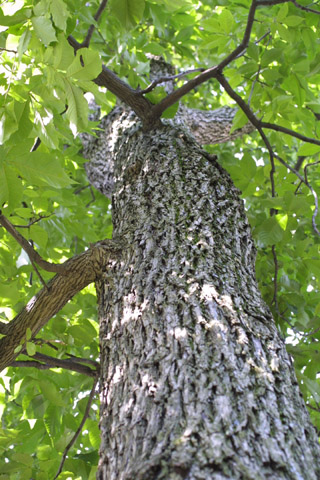
|

|

|

|
An individual instance of Carya ovalis (red hickory)

Permanent unique identifier for this particular organism:
http://bioimages.vanderbilt.edu/vanderbilt/12-20
Notes:
This tree is in the greenspace on the east side of 21st Ave. S. across from the entrance of the medical arts building.
Red hickory leaves usually have seven leaflets (occasionally 5) and its mature buds are usually reddish, in contrast to the yellow buds of bitternut hickory (Carya cordiformes). The twigs are also more slender than the twigs of mockernut hickory (Carya tomentosa), another hickory with 7 leaflets. The bark is tight, unlike the shaggy bark of kingnut hickory (Carya laciniosa), which also typically has 7 (or 9) leaflets. To systematically separate hickory species, see the key to hickories. The fruits of red hickory have a relatively thin husk and their nuts are good to eat. Red hickory is fairly common in middle Tennessee. However, it often hybridizes with other hickory species (such as shagbark hickory) and so it is sometimes not possible to classify individuals to species unambiguously. This is the only known red hickory on Vanderbilt's campus.
Red hickory leaves usually have seven leaflets (occasionally 5) and its mature buds are usually reddish, in contrast to the yellow buds of bitternut hickory (Carya cordiformes). The twigs are also more slender than the twigs of mockernut hickory (Carya tomentosa), another hickory with 7 leaflets. The bark is tight, unlike the shaggy bark of kingnut hickory (Carya laciniosa), which also typically has 7 (or 9) leaflets. To systematically separate hickory species, see the key to hickories. The fruits of red hickory have a relatively thin husk and their nuts are good to eat. Red hickory is fairly common in middle Tennessee. However, it often hybridizes with other hickory species (such as shagbark hickory) and so it is sometimes not possible to classify individuals to species unambiguously. This is the only known red hickory on Vanderbilt's campus.

|

|
|
Load database and switch to thumbnail view
Use this stable URL to link to this page:
http://bioimages.vanderbilt.edu/vanderbilt/12-20.htm
This organism is a living specimen that is part of the Vanderbilt University Arboretum with the local identifier 1-714.
This particular organism is believed to have managed means of establishment.
This organismal entity has the scope: multicellular organism.
Remarks: Mentioned in 1994 Trees of Vanderbilt book p.73.
Identifications:
Carya ovalis
(Wangenh.) Sarg.
sec. Gleason Cronquist 1991
common name: red hickory
family: Juglandaceae
Identified 2002-06-26 by Steven J. Baskauf
Location:
Vanderbilt University, Nashville, Davidson County, Tennessee, US
Click on these geocoordinates to load a map showing the location: 36.14243°, -86.79988°
Coordinate uncertainty about: 10 m.
Location of individual determined from GIS database.
Occurrences were recorded for this particular organism on the following dates:
2002-06-26
2002-06-27
2003-04-23
2003-04-29
2003-05-01
2003-10-03
2003-10-16
2014-09-11
The following images document this particular organism.
Click on a thumbnail to view the image and its metadata. Load database and enable navigation by taxon and organism.



















